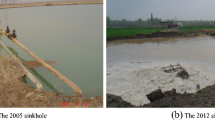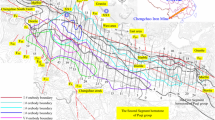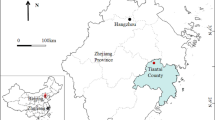Abstract
In the thinly bedded salt formations, due to the limited thickness of the salt strata along with the fast upward dissolution, the collapse of the non-salt roof of the cavern often occurs, leading to the leakage of brine and instability of the cavern as well as other undesirable geological consequences. To investigate the gypsum-salt interbedded roof collapse, the failure mechanism and the control methods of Dainan siltstone, which is the indirect roof of the horizontal salt caverns in Zhaoji Salt Mine, were thoroughly investigated. Through the drilled cores from this mine, a series of contrast tests such as SEM, EDS, XRD, soaking, and nuclear magnetic properties were carried out to study the physical properties of the salt layer and non-salt layer of the cavern roof and to determine the cavern roof collapse and leakage mechanism. Using the Comsol software, the model of a horizontal cavern roof leakage was established, and the leakage range and leakage of brine at different time were analyzed, as well as the safety problems caused by it. Finally, some suggestions have been provided for the leakage control of the cavern roof in bedded salt cavern.















Similar content being viewed by others
References
Bekendam F, Oldenziel CE, Paar W (2000) Subsidence potential of the hengelo brine field (Part I). Physico-Chemical deterioration and mechanical failure of salt cavern roof layers. In: Proceedings technical class and technical session, SMRI Fall Meeting, San Antonio. 15–16 October 2000. pp 103–117
Bérest P (2017) Cases, causes and classifications of craters above salt caverns. Int J Rock Mech Min Sci 100:318–319
Cai MF, He MC, Liu DY (2002) Rock Mechanics and Engineering[M]. Science Press, Beijing
Chen J, Jiang D, Ren S, Yang C (2016) Comparison of the characteristics of rock salt exposed to loading and unloading of confining pressures. Acta Geotech 11(1):221–230
Chen X, Li Y, Liu W et al (2018) Study on sealing failure of wellbore in bedded salt cavern gas storage[J]. Rock Mech Rock Eng 2018:1–14
Cosenza P, Ghoreychi M, Bazargan-Sabet B, de Marsily G (2009) In situ rock salt permeability measurement for long term safety assessment of storage. Int J Rock Mech Min Sci 36:509–526
Cuevas CDL (1997) Pore structure characterization in rock salt. Eng Geol 47(1–2):17–30
Djizanne H, Bérest P, Brouard B (2014) The mechanical stability of a salt cavern used for compressed air energy storage (CAES). Solution Mining Research Institute Spring 2014 Technical Conference San Antonio, Texas, USA, 5–6 May 2014
Houben ME, Hove AT, Peach CJ, Spiers CJ (2013) Crack healing in rock salt via diffusion in adsorbed aqueous films: microphysical modelling versus experiments. Phys Chem Earth 64:95–104
COMSOL Multiphysics User's guide (2014)
Johnson DO, Seni SJ (2001) Regulation of hydrocarbon storage operations in Texas. In: Proc SMRI Spring Meeting, Orlando, pp 111–120
Li Y, Shi X, Yang C, Qu D (2012) Several key problems about control of solution mining for oil/gas storage in deep salt mine. Chin J Rock Mech Eng 31(9):1785–1796 (in Chinese)
Liu W, Chen J, Jiang D, Shi X, Li Y, Daemen JJK et al (2016a) Tightness and suitability evaluation of abandoned salt caverns served as hydrocarbon energies storage under adverse geological conditions (AGC). Appl Energy 178:703–720
Liu W, Muhammad N, Chen J, Spiers CJ, Peach CJ, Jiang D et al (2016b) Investigation on the permeability characteristics of bedded salt rocks and the tightness of natural gas caverns in such formations. J Nat Gas Sci Eng 35:468–482
Liu X, Yang X, Wang J, Li D, Li P, Yang Z (2016c) A dynamic dissolution model of rock salt under gravity for different flow rates. Arab J Geosci 9(3):1–8
Liu W, Jiang D, Chen J, Tang K, Wu F, Shi X (2018) Comprehensive feasibility study of two-well-horizontal caverns for natural gas storage in thinly-bedded salt rocks in China. Energy 143:1006–1019
Lux KH (2009) Design of salt caverns for the storage of natural gas, crude oil and compressed air: geomechanical aspects of construction, operation and abandonment. Geol Soc Lond Spec Publ 313:93–128
Ma H, Yang C, Li Y, Shi X, Liu J et al (2015) Stability evaluation of the underground gas storage in rock salts based on new partitions of the surrounding rock. Environ Earth Sci 73(11):6911–6925
Preece D, Foley J (1983) Finite element analysis of salt cavern employed in the strategic petroleum reserve. In: Proceedings of 6th International symposium on salt, 49–63
Preece D, Foley J (1984). Long-term performance predictions for SPR salt caverns. SAND83-2343, Sandia National Laboratories, Albuquerque, NM
Shi X, Li Y, Yang C et al (2009) Experimental study on the effect of brine immersion on the tensile strength of argillaceous interlayer. Chin J Rock Mech Eng 28(11):2301–2308
Shi X, Li Y, Yang C, Xu Y, Ma H, Wei L et al (2015) Influences of filling abandoned salt caverns with alkali wastes on surface subsidence. Environ Earth Sci 73(11):6939–6950
Shi X, Liu W, Chen J, Jiang D, Wu F, Zhang J et al (2018) Softening model for failure analysis of insoluble interlayers during salt cavern leaching for natural gas storage. Acta Geotech 13(4):801–816
Wang J, Zhang S, Zhao B, Liu X, Liu J, Lai J (2018) A study on the mechanical behavior and statistical damage constitutive model of sandstone. Arab J Sci Eng 43(10):5179–5192
Wu F, Chen J, Zou Q (2018) A nonlinear creep damage model for salt rock. Int J Frac Eng Int J Damage Mech. https://doi.org/10.1177/1056789518792649
Xing W, Zhao J, Hou Z et al (2015) Horizontal natural gas caverns in thin-bedded rock salt formations. Environ Earth Sci 73(11):6973–6985
Yang C, Jing W, Daemen JJK, Zhang G (2013) Analysis of major risks associated with hydrocarbon storage caverns in bedded salt rock. Reliab Eng Syst Safe 113(1):94–111
Yang C, Wang T, Li Y, Yang H, Li J, Qu D et al (2015) Feasibility analysis of using abandoned salt caverns for large-scale underground energy storage in China. App Energy 137:467–481
Yang C, Wang T, Qu D, Ma H, Li Y, Shi X et al (2016) Feasibility analysis of using horizontal caverns for underground gas storage: a case study of Yunying salt district. J Nat Gas Sci Eng 36:252–266
Yuan W, Wang W, Su X, Li Li Jia, Zong Li, Wen L et al (2018) Numerical study of the impact mechanism of decoupling charge on blasting-enhanced permeability in low-permeability sandstones. Int J Rock Mech & Min Sci 2018(106):300–310
Zhang G, Li Y, Yang C, Daemen JJK (2014) Stability and tightness evaluation of bedded rock salt formations for underground gas/oil storage. Acta Geotech 9(9):161–179
Zhang G, Li Y, Daemen JJK, Yang C, Wu Y (2015) Geotechnical feasibility analysis of compressed air energy storage (CAES) in bedded salt formations: a case study in Huai’an City, China. Rock Mech Rock Eng 48(5):2111–2127
Zhang N, Shi X, Wang T, Yang C, Liu W (2017) Stability and availability evaluation of underground strategic petroleum reserve (SPR) caverns in bedded rock salt of Jintan, China. Energy 134:504–514
Acknowledgements
The authors would gratefully like to acknowledge the financial support from National Natural Science Foundation of China (No. 51604144, 41672292, 41472285, 51834003); the Fundamental Research Fund for the Central Universities (2018CDXYZH0006); Chongqing Basic Research and Frontier Exploration Project (cstc2018jcyjAX0441).
Author information
Authors and Affiliations
Corresponding author
Additional information
Publisher's Note
Springer Nature remains neutral with regard to jurisdictional claims in published maps and institutional affiliations.
Rights and permissions
About this article
Cite this article
Zhang, Z., Jiang, D., Liu, W. et al. Study on the mechanism of roof collapse and leakage of horizontal cavern in thinly bedded salt rocks. Environ Earth Sci 78, 292 (2019). https://doi.org/10.1007/s12665-019-8292-2
Received:
Accepted:
Published:
DOI: https://doi.org/10.1007/s12665-019-8292-2




